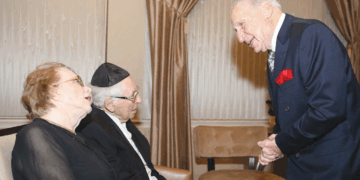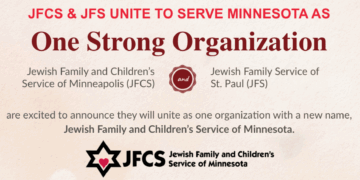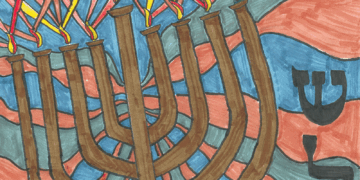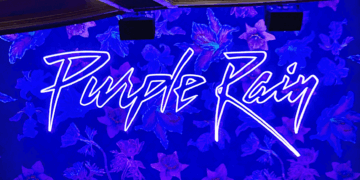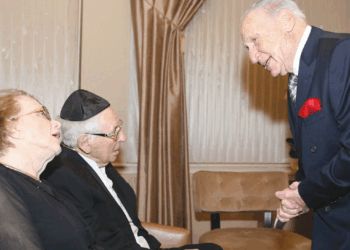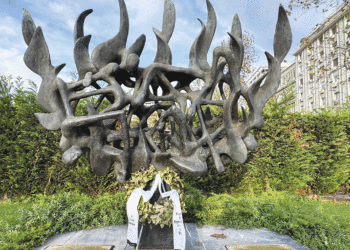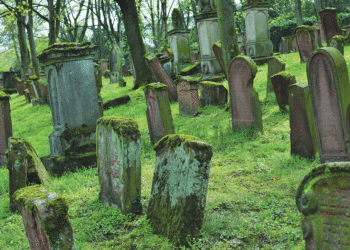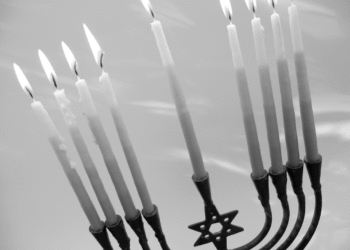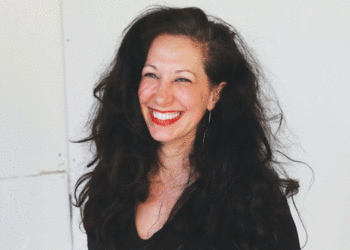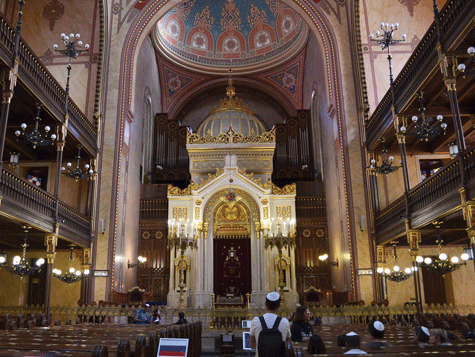
Photos and story by MORDECAI SPECKTOR
BUDAPEST, Hungary — In April, I rented an apartment directly across the street from the Rumbach Street Synagogue, a towering structure now undergoing extensive renovation. Whether the shul would become a Jewish cultural center or be recycled for some other use, nobody seemed to know.
I left my rental in the center of Budapest’s historical Jewish quarter on April 14, on my way back to Minneapolis, via Prague. Apparently, two days after I left the apartment on Rumbach Sebestyén Street, a memorial plaque was affixed next to the building’s front gate. The marker, which I recently saw in an Instagram post, notes that the building had “one of the only remaining water taps” in the Jewish Ghetto, which allowed a chance for survival to many of the 70,000 Jews penned in “under Arrow Cross terror”; those “doomed to death” by the Hungarian Arrow Cross were “liberated by the Red Army” in January 1945.
The Arrow Cross members were Hungarian fascists, henchmen of the Nazis. In December 1944 and January 1945, Arrow Cross militia men went on a murderous rampage, plundering, beating and murdering Jews. Thousands of Jews were marched out of the Budapest ghetto to the Pest bank of the Danube River and shot, their bodies pushed into the freezing waters. A monument called Shoes on the Danube, cast-iron shoes of various sizes and styles anchored on the river embankment, remembers the victims of this horrific massacre (4-20-18 AJW).
During several days in Budapest, an amazing lively city, I had the opportunity to talk with Jewish communal leaders and with young engaged Jews. An American Jewish visitor is mindful of the emotionally fraught and blood-drenched history in this area of Central Europe; but Jews in Budapest, while doubtless mindful of the past, are busy forging a vibrant community. Here is what they told me.
***
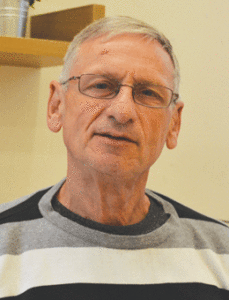
During a visit to Balint Haz JCC, the only Jewish community center in Hungary, I first talked with Colin Bulka, a native of London who is the director of the American Jewish Joint Distribution Committee, Hungary (aka JDC or the Joint). Bulka had been in his post for just nine months and said: “The whole revival of the Hungarian Jewish community, which the Joint has been a huge part of… has been this incredible vehicle; and we’ve kind of ended up with the reverse model, where a group of young people getting involved in activities have revitalized Jewish life, bottom up…. Instead of the model I learned where Judaism comes down from your parents and your grandparents — and in Israel, where you simply get it because you’re born there — here it’s coming up from your children to your parents and grandparents.…
“Here in Budapest there are four Jewish day schools, four streams of Judaism, a Jewish university, a Jewish kindergarten, a Moishe House, a Limmud, a JCC, summer camps, two Zionist youth movements, a BBYO youth group… various Holocaust projects… a Jewish magazine. Wow! How did that happen from almost nothing?”
***
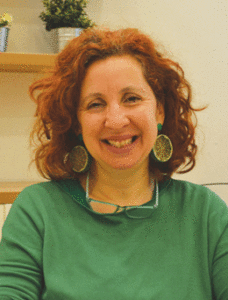
Zsuzsa Fritz, 52, director of Balint Haz JCC (a JDC Hungary-supported institution), showed me a photo of her father:
“So this is me, this is my father, these are my siblings and nephew and niece. He was 57 when he passed away, of lung cancer; and I didn’t know I was Jewish until that moment. I was 16 at the time, and basically at his funeral I put the picture together that I’m Jewish…. I had no idea, although I had grown up with my maternal grandparents who were also Jewish, my mother was also Jewish…. For me, my father was always the symbol of humor and cheerfulness and fun. He would always make jokes, and was full of life, of love of life. We went hiking and travelling as much as we could in the 1970s and ’80s…. My father was a taxi driver; he tried a lot of different professions, he tried a lot of different wives, and only quite late in my life did I understand why, that he was basically searching for belonging….
“A few years ago, I got a message on Facebook from a lady who I didn’t know and was sending me a family tree… asking me if I recognized my family [Fritz]…. I was curious, so I went to the community archives and found out that he lost everyone besides his grandmother, so it’s him and his grandmother who came back, all the rest was killed in Auschwitz, including his identical twin brother. And that’s when I understood that all his life… he just wanted to belong.”
***
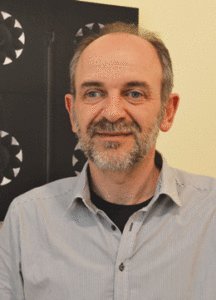
Mircea Cernov, 53, director of the Mozaik Jewish Community Hub, a JDC Hungary project, was born in Romania and made aliya with his family in 1986. The Mozaik Hub is part co-working space and part nonprofit incubator. I asked him about Hungarians who learned only later in life about their Jewish ancestry.
“It’s something very common in Hungary, and in this part of the world… where the Communist regime actually didn’t allow, or there was no real community life, or different ethnic or cultural or religious identities were not part of the conversation…. And this is true also of Jewish life. Because of the Holocaust and the Communist region that came after… this was not a topic, was not allowed, and so at a very personal level people prefer not to talk about it. And that’s why many many people grew up without knowing that they are Jews and without getting any kind of Jewish life… and many people discovered only late in their life that they are Jews and that there is a possibility to live as a Jew and be part of the Jewish community.
“Since the change that happened in ’89-’90, actually, there is a new generation of people that — exactly because of the support and investment of JDC and other Jewish community organizations — had the opportunity in the last 25 or 30 years to learn, to become engaged, to connect to the Jewish community. One of the roles of JDC, and also of the Hub — although it’s focusing on professional development and capacity building and organizational development — is reaching out to Jewish people, young and middle-aged, and providing opportunities for involvement and engagement in Jewish life and in the Jewish community.
***
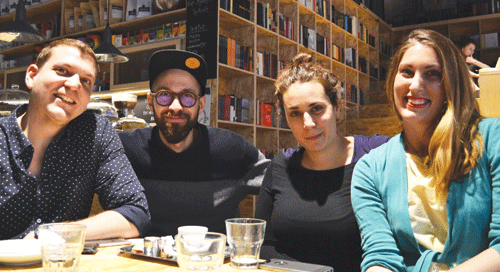
Tomi Büchler, who visited the Jewish World offices in February (2-9-18 AJW), met me at my apartment in Budapest and we took a short walk to Magvető Café, a cool bookstore and café on Dohány Street.
If you don’t recall the story I wrote, Tomi works for the Jewish Agency for Israel and helped found and leads a group called Minyanim, which aims to reignite Judaism and Jewish life among young Jews in Hungary and other European countries.
He arranged for me to meet a group of young engaged Budapest Jews: Gyuri Hamori, 31; Luca Elek, 31; and Sara Ozorai, 29. We had a brief discussion about the April 8 parliamentary elections, and whether the vote was rigged and why people opted for the xenophobic appeal of Orban and his Fidesz Party. (I’ll write about the rise of right-wing nationalism in Hungary in the June 1 edition.)
Pursuing the topic of Jewish identity, or the lack of, in Hungary, Luca commented, “I was raised in a very secular family, although I always knew I am Jewish.” She was aware of the Holocaust and “missing relatives.” Her parents enrolled her in the Lauder primary school, a Jewish school, as a sort of corrective to their “socialist, Communist” family background. “They wanted me to have a choice, if I wanted to be involved or not. It was a great school, I had a great time.”
Luca got involved in Minyanim, which she called a “life-changing thing.” And an international seminar about Jewish involvement in social justice opened her eyes to new possibilities regarding Jewish activism. She also went on a Birthright Israel trip, in 2010, along with Gyuri. “For us, it was very very new, Israel and Judaism,” she commented about Birthright.
Gyuri questioned the oft cited figure of 100,000 Jews, or people with Jewish ancestry, in Hungary. “That’s a questionable number,” he argued, designed to bring in donations from Jewish organizations outside of Hungary. “The number of the active [Jewish] community is probably less than 10,000.”
He continued, “This is not a Jewish community like anywhere else in the world, because here the national identity, the ethnicity, the religious identity, these are all separate.” In practice, he said, there are people who say they’re Jewish, “but they have little to do with the actual Jewish community.”
Gyuri commented that many young Hungarians going on Birthright have scant connection to the Jewish community before the trip, but the experience affords them a great opportunity to connect to the local community and to their Jewish identity.
Even those more involved in the Jewish community don’t necessarily know anything about Judaism; instead they’re in it for a “sense of belonging — nothing Jewish,” according to Gyuri. “They get just this irrational identity.”
Sara Ozorai was raised by a Jewish film producer and a mother from a Catholic family. Her maternal grandmother was very religious, so Sara was baptized — and then attended a Jewish school. Like Luca, she went on a Birthright trip. “It kind of changed my life,” she commented.
Since going on Birthright several years ago, Sara has been involved with the Israeli Cultural Institute in Budapest — the only Israeli cultural center in the world — and with Minyanim. She has visited Israel many times, and mentioned participating in Project 10 at Kibbutz Harduf, a Jewish Agency program that brings together young Jewish adults from around the world for volunteer work in local communities.
And then Sara told me a story that nearly made me cry. She applied for the MASA program, a year-long study program in Israel, and was rejected because she was judged not to be Jewish enough.
It certainly is Israel’s loss, if they reject someone as sincere and dedicated to exploring Judaism and enhancing Jewish life as is Sara.
(American Jewish World, 5.18.18)

